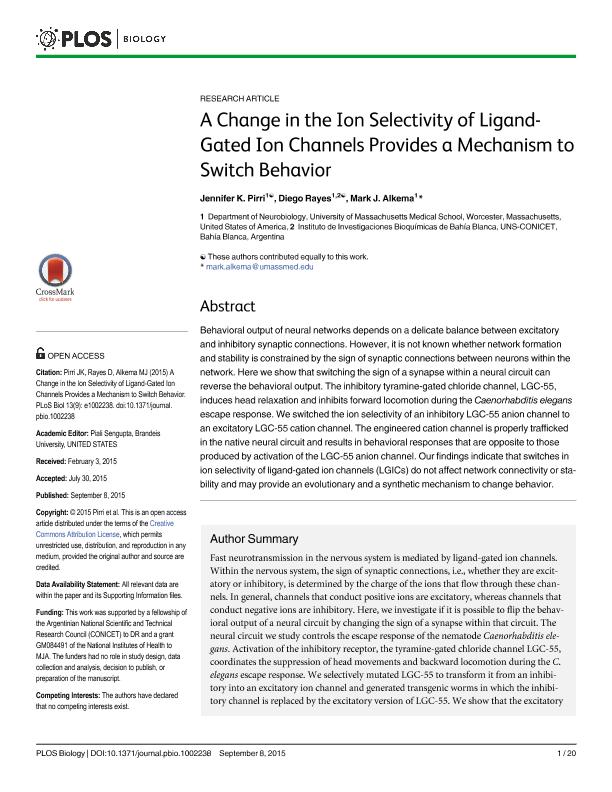Artículo
Behavioral output of neural networks depends on a delicate balance between excitatory and inhibitory synaptic connections. However, it is not known whether network formation and stability is constrained by the sign of synaptic connections between neurons within the network. Here we show that switching the sign of a synapse within a neural circuit can reverse the behavioral output. The inhibitory tyramine-gated chloride channel, LGC-55, induces head relaxation and inhibits forward locomotion during the Caenorhabditis elegans escape response. We switched the ion selectivity of an inhibitory LGC-55 anion channel to an excitatory LGC-55 cation channel. The engineered cation channel is properly trafficked in the native neural circuit and results in behavioral responses that are opposite to those produced by activation of the LGC-55 anion channel. Our findings indicate that switches in ion selectivity of ligand-gated ion channels (LGICs) do not affect network connectivity or sta- bility and may provide an evolutionary and a synthetic mechanism to change behavior. Author Summary
Fast neurotransmission in the nervous system is mediated by ligand-gated ion channels. Within the nervous system, the sign of synaptic connections, i.e., whether they are excit- atory or inhibitory, is determined by the charge of the ions that flow through these chan- nels. In general, channels that conduct positive ions are excitatory, whereas channels that conduct negative ions are inhibitory. Here, we investigate if it is possible to flip the behav- ioral output of a neural circuit by changing the sign of a synapse within that circuit. The neural circuit we study controls the escape response of the nematode Caenorhabditis ele- gans. Activation of the inhibitory receptor, the tyramine-gated chloride channel LGC-55, coordinates the suppression of head movements and backward locomotion during the C. elegans escape response. We selectively mutated LGC-55 to transform it from an inhibi- tory into an excitatory ion channel and generated transgenic worms in which the inhibi- tory channel is replaced by the excitatory version of LGC-55. We show that the excitatory version of LGC-55 is properly localized to the postsynaptic compartments, is activated by the natural ligand, and does not affect network connectivity or stability. However, its expression leads to behavioral responses that are opposite to those produced by activation of the native inhibitory channel. We propose that switching the sign of a synapse not only provides a synthetic mechanism to flip behavioral output but could also be an evolutionary mechanism to change behavior.
A change in the ion selectivity of ligand-gated ion channels provides a mechanism to switch behavior.
Fecha de publicación:
09/2015
Editorial:
Public Library Of Science
Revista:
Plos Biology
ISSN:
1544-9173
Idioma:
Español
Tipo de recurso:
Artículo publicado
Clasificación temática:
Resumen
Palabras clave:
C. Elegans
,
Behavior
,
Neural Circuit
,
Synaptic Engineering
Archivos asociados
Licencia
Identificadores
Colecciones
Articulos(INIBIBB)
Articulos de INST.DE INVEST.BIOQUIMICAS BAHIA BLANCA (I)
Articulos de INST.DE INVEST.BIOQUIMICAS BAHIA BLANCA (I)
Citación
Pirri, Jennifer; Rayes, Diego Hernán; Alkema, Mark J.; A change in the ion selectivity of ligand-gated ion channels provides a mechanism to switch behavior.; Public Library Of Science; Plos Biology; 13; 9; 9-2015; e1002238
Compartir
Altmétricas




